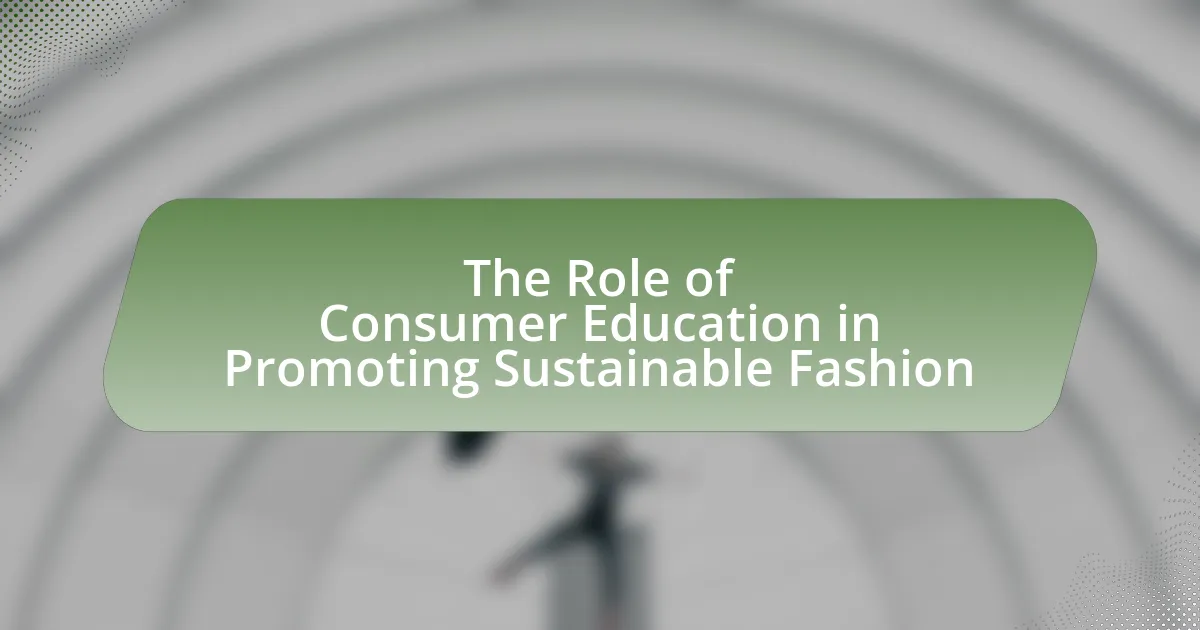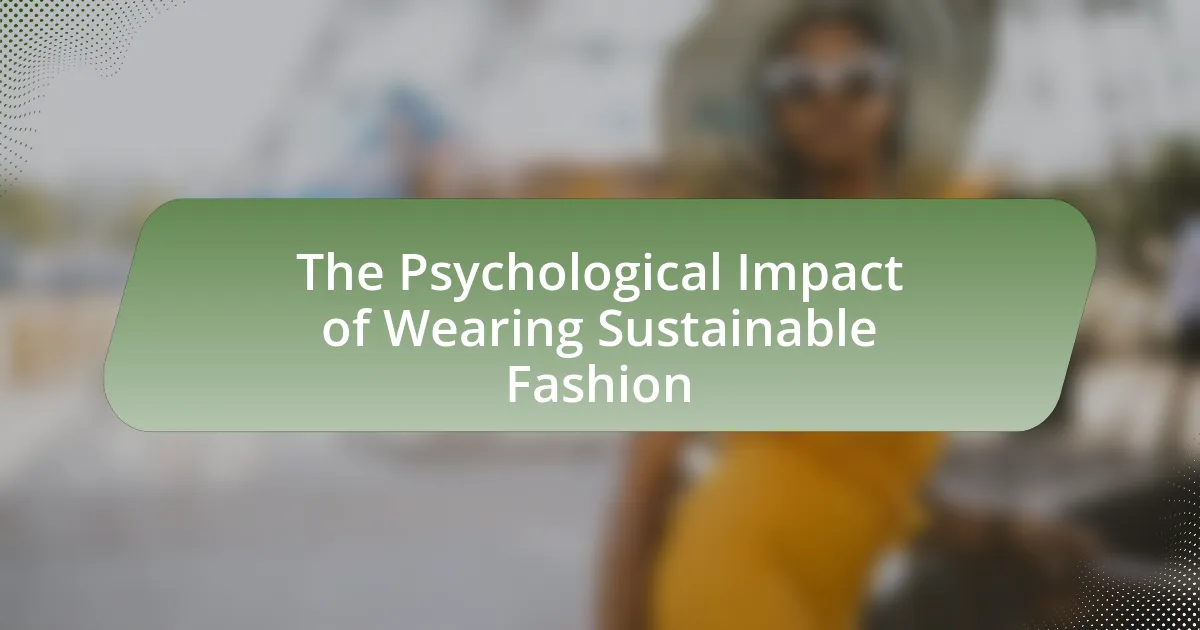Biodegradable materials in fashion are substances that decompose naturally, significantly reducing environmental impact compared to traditional synthetic fibers. This article explores the characteristics, benefits, and types of biodegradable materials, such as organic cotton, hemp, and Tencel, highlighting their role in minimizing landfill waste and greenhouse gas emissions. It also examines the challenges faced in adopting these materials, including production costs and consumer awareness, while showcasing leading brands that are pioneering sustainable practices. Additionally, the article discusses innovations and collaborative efforts within the industry to enhance biodegradable options, emphasizing the importance of consumer support in driving the shift towards eco-friendly fashion.

What are Biodegradable Materials in Fashion?
Biodegradable materials in fashion are substances that can decompose naturally through biological processes, reducing environmental impact. These materials include organic fibers like cotton, linen, and hemp, as well as innovative alternatives such as Tencel, made from sustainably sourced wood pulp. Research indicates that biodegradable materials can significantly decrease landfill waste, as they break down into non-toxic components, unlike synthetic fibers that persist for decades. For instance, a study published in the journal “Environmental Science & Technology” highlights that cotton can decompose within a few months under the right conditions, demonstrating its potential for sustainable fashion practices.
How do biodegradable materials differ from traditional materials?
Biodegradable materials differ from traditional materials primarily in their ability to decompose naturally through biological processes. Traditional materials, such as plastics and synthetic fibers, can take hundreds of years to break down, often resulting in environmental pollution. In contrast, biodegradable materials, like those derived from natural sources such as plant fibers or starch, can decompose within months to a few years under the right conditions, significantly reducing their environmental impact. This difference is crucial for sustainable practices in industries like fashion, where the shift towards biodegradable options aims to minimize waste and promote eco-friendliness.
What are the key characteristics of biodegradable materials?
Biodegradable materials are substances that can be broken down by natural processes, primarily through the action of microorganisms. Key characteristics include their ability to decompose into non-toxic components, typically within a specific timeframe, which can range from a few weeks to several months, depending on environmental conditions. Additionally, biodegradable materials often originate from renewable resources, such as plant-based materials, which contribute to sustainability. They also tend to produce fewer greenhouse gases during decomposition compared to traditional plastics, making them environmentally friendly alternatives.
Why is biodegradability important in the fashion industry?
Biodegradability is important in the fashion industry because it significantly reduces environmental impact by ensuring that materials decompose naturally, minimizing landfill waste. The fashion industry is one of the largest polluters globally, with an estimated 92 million tons of textile waste generated annually, much of which ends up in landfills where it can take decades to break down. Biodegradable materials, such as organic cotton or Tencel, can decompose within months, thus alleviating the burden on waste management systems and reducing greenhouse gas emissions associated with decomposition in landfills. This shift towards biodegradable options aligns with increasing consumer demand for sustainable practices, as 66% of global consumers are willing to pay more for sustainable brands, highlighting the economic viability of adopting biodegradable materials in fashion.
What types of biodegradable materials are used in fashion?
Biodegradable materials used in fashion include organic cotton, hemp, Tencel (lyocell), and biodegradable polyester. Organic cotton is cultivated without synthetic pesticides, making it more environmentally friendly. Hemp is a fast-growing plant that requires minimal resources and is fully biodegradable. Tencel, derived from sustainably sourced wood pulp, is known for its biodegradability and low environmental impact. Biodegradable polyester, often made from renewable resources, can decompose under specific conditions, reducing landfill waste. These materials contribute to sustainable fashion practices by minimizing environmental harm and promoting circularity in the industry.
What are the most common biodegradable fabrics?
The most common biodegradable fabrics include cotton, linen, hemp, and Tencel. Cotton is a natural fiber derived from the cotton plant, known for its softness and breathability, and it decomposes within a few months under the right conditions. Linen, made from the flax plant, is also biodegradable and breaks down in a similar timeframe. Hemp is recognized for its durability and rapid growth, making it an eco-friendly option that decomposes within a few years. Tencel, produced from sustainably sourced wood pulp, is biodegradable and can decompose in a matter of weeks to months in industrial composting conditions. These fabrics contribute to sustainable fashion by reducing environmental impact through their natural decomposition processes.
How are natural fibers utilized in biodegradable fashion?
Natural fibers are utilized in biodegradable fashion by serving as sustainable materials that decompose naturally, reducing environmental impact. These fibers, such as cotton, hemp, and linen, are derived from plants and are preferred for their ability to break down in soil, unlike synthetic fibers which contribute to pollution. Research indicates that natural fibers can decompose within a few months to a few years, depending on conditions, making them a viable option for eco-friendly clothing and accessories. For instance, a study published in the Journal of Cleaner Production highlights that cotton biodegrades in approximately 3 to 5 months, demonstrating its effectiveness in sustainable fashion practices.

How are Biodegradable Materials Transforming the Fashion Industry?
Biodegradable materials are transforming the fashion industry by providing sustainable alternatives to traditional textiles, significantly reducing environmental impact. These materials, such as organic cotton, Tencel, and biodegradable polyester, decompose naturally, minimizing landfill waste and pollution. For instance, a study published in the journal “Environmental Science & Technology” found that biodegradable fabrics can reduce the carbon footprint of clothing production by up to 30%. Additionally, brands like Stella McCartney and Adidas are increasingly adopting biodegradable materials in their collections, demonstrating a shift towards eco-friendly practices that appeal to environmentally conscious consumers. This transformation not only addresses sustainability concerns but also drives innovation in material science within the fashion sector.
What are the environmental benefits of using biodegradable materials?
Biodegradable materials significantly reduce environmental pollution by breaking down naturally and returning to the ecosystem without leaving harmful residues. Unlike conventional plastics, which can take hundreds of years to decompose, biodegradable materials typically decompose within months to a few years, thereby minimizing landfill waste and reducing the accumulation of microplastics in the environment. According to a study published in the journal “Environmental Science & Technology,” biodegradable plastics can reduce greenhouse gas emissions by up to 68% compared to traditional plastics, contributing to lower carbon footprints. Additionally, the use of biodegradable materials supports soil health by enriching it as they decompose, promoting a sustainable cycle of nutrients.
How do biodegradable materials reduce waste in the fashion industry?
Biodegradable materials reduce waste in the fashion industry by breaking down naturally over time, thus minimizing landfill contributions. Unlike conventional textiles, which can take decades to decompose, biodegradable fabrics such as organic cotton, Tencel, and hemp decompose within months to a few years, significantly lowering the volume of waste generated. For instance, a study published in the journal “Environmental Science & Technology” found that biodegradable materials can reduce the environmental impact of textile waste by up to 90% compared to synthetic fibers. This rapid decomposition process not only lessens the burden on waste management systems but also contributes to a more sustainable lifecycle for fashion products.
What impact do biodegradable materials have on carbon footprints?
Biodegradable materials significantly reduce carbon footprints by decomposing naturally and minimizing greenhouse gas emissions compared to traditional plastics. When biodegradable materials break down, they typically release fewer carbon emissions, especially when composted in controlled environments, as opposed to conventional plastics that can persist for hundreds of years and contribute to ongoing carbon emissions during their lifecycle. Studies indicate that using biodegradable alternatives can lower carbon emissions by up to 50% in certain applications, highlighting their potential for mitigating climate change impacts in industries like fashion.
How are brands adopting biodegradable materials?
Brands are adopting biodegradable materials by integrating them into their product lines and packaging solutions. For instance, companies like Stella McCartney and Adidas have developed clothing and footwear made from biodegradable fabrics such as organic cotton and innovative materials like mycelium leather. Additionally, brands are utilizing biodegradable packaging options, with Unilever committing to making all of its plastic packaging recyclable, reusable, or compostable by 2025. This shift is supported by consumer demand for sustainable practices, as a 2021 survey indicated that 66% of global consumers are willing to pay more for sustainable brands.
Which fashion brands are leading the way in biodegradable fashion?
Leading the way in biodegradable fashion are brands such as Stella McCartney, Eileen Fisher, and Pangaia. Stella McCartney is renowned for its commitment to sustainable practices, utilizing biodegradable materials like organic cotton and recycled polyester in its collections. Eileen Fisher focuses on circular fashion, incorporating biodegradable fibers such as Tencel and organic linen, which decompose naturally. Pangaia is notable for its innovative use of bio-based materials, including its signature Pangaia 365 collection made from natural fibers that break down in the environment. These brands exemplify the shift towards sustainable fashion by prioritizing materials that minimize environmental impact.
What strategies are brands using to promote biodegradable materials?
Brands are using several strategies to promote biodegradable materials, including educational campaigns, sustainable packaging, and collaborations with environmental organizations. Educational campaigns aim to inform consumers about the benefits of biodegradable materials, highlighting their environmental advantages over traditional materials. Sustainable packaging initiatives involve using biodegradable materials for product packaging, which not only reduces waste but also enhances brand image. Collaborations with environmental organizations help brands gain credibility and reach a wider audience, as these partnerships often involve joint marketing efforts that emphasize sustainability. These strategies collectively contribute to increasing consumer awareness and acceptance of biodegradable materials in the fashion industry.

What Challenges Exist in the Adoption of Biodegradable Materials?
The challenges in the adoption of biodegradable materials include high production costs, limited consumer awareness, and inadequate waste management infrastructure. High production costs hinder manufacturers from scaling up biodegradable material production, making them less competitive compared to conventional materials. Limited consumer awareness results in lower demand, as many consumers are not informed about the benefits and availability of biodegradable options. Additionally, inadequate waste management infrastructure complicates the effective disposal and composting of biodegradable materials, leading to contamination with non-biodegradable waste. These factors collectively impede the widespread adoption of biodegradable materials in the fashion industry.
What are the limitations of biodegradable materials in fashion?
Biodegradable materials in fashion face several limitations, including durability, production costs, and environmental conditions for degradation. These materials often lack the strength and longevity of traditional fabrics, leading to shorter product lifespans. Additionally, the production of biodegradable textiles can be more expensive due to the specialized processes and raw materials required, which may deter brands from adopting them. Furthermore, the effectiveness of biodegradation is highly dependent on specific environmental conditions, such as temperature and moisture, which may not be present in typical landfill settings, thus limiting their environmental benefits.
How do performance issues affect the use of biodegradable materials?
Performance issues significantly limit the use of biodegradable materials in fashion. These materials often exhibit lower durability, reduced strength, and limited resistance to environmental factors compared to traditional materials. For instance, studies have shown that biodegradable fabrics can degrade more quickly under moisture and UV exposure, leading to shorter product lifespans. This degradation can result in garments that lose their structural integrity and aesthetic appeal faster, which may deter consumers seeking longevity in their purchases. Additionally, performance inconsistencies can hinder the ability of manufacturers to meet quality standards, impacting brand reputation and market competitiveness.
What are the cost implications of switching to biodegradable materials?
Switching to biodegradable materials typically incurs higher initial costs compared to conventional materials. For instance, biodegradable fabrics can be 20% to 50% more expensive due to the cost of raw materials and production processes. However, these costs may be offset by long-term savings in waste management and potential regulatory incentives. A study by the Ellen MacArthur Foundation highlights that transitioning to sustainable materials can lead to reduced environmental impact and lower disposal costs over time, supporting the economic viability of biodegradable options in the fashion industry.
How can the fashion industry overcome these challenges?
The fashion industry can overcome challenges by adopting biodegradable materials and implementing sustainable practices throughout the supply chain. By transitioning to materials such as organic cotton, Tencel, and biodegradable polyester, brands can significantly reduce their environmental impact. For instance, a study published in the Journal of Cleaner Production found that using biodegradable materials can decrease waste and pollution associated with traditional textiles. Additionally, investing in technology for recycling and circular fashion models can further mitigate challenges, as demonstrated by companies like Stella McCartney, which have successfully integrated sustainable practices into their business models.
What innovations are being developed to enhance biodegradable materials?
Innovations being developed to enhance biodegradable materials include the creation of bioplastics derived from renewable resources, such as cornstarch and sugarcane, which decompose more efficiently than traditional plastics. Research has shown that these bioplastics can break down in industrial composting facilities within months, compared to hundreds of years for conventional plastics. Additionally, advancements in microbial fermentation processes are enabling the production of biodegradable polymers that mimic the properties of synthetic materials while being environmentally friendly. For instance, a study published in the journal “Nature” by researchers at the University of Cambridge demonstrated that polyhydroxyalkanoates (PHAs), produced by bacteria, can serve as a sustainable alternative to petroleum-based plastics, offering similar durability and flexibility.
How can collaboration within the industry support biodegradable practices?
Collaboration within the fashion industry can significantly enhance biodegradable practices by fostering innovation, sharing resources, and establishing standardized guidelines. When brands, manufacturers, and researchers work together, they can develop new biodegradable materials that meet both environmental and consumer demands. For instance, partnerships between textile companies and universities have led to the creation of innovative fabrics made from organic materials, which decompose more efficiently than traditional textiles. Additionally, collaborative initiatives like the Fashion for Good program encourage knowledge sharing and best practices among industry players, promoting the adoption of biodegradable options across supply chains. This collective effort not only accelerates the transition to sustainable materials but also helps in educating consumers about the benefits of biodegradable fashion, ultimately driving market demand for eco-friendly products.
What practical steps can consumers take to support biodegradable fashion?
Consumers can support biodegradable fashion by choosing brands that prioritize sustainable materials and practices. This includes researching and purchasing clothing made from natural fibers like organic cotton, hemp, or Tencel, which are designed to decompose more easily than synthetic materials. Additionally, consumers can advocate for transparency in the fashion industry by asking brands about their sourcing and production methods, thereby encouraging companies to adopt biodegradable options. Supporting local and small-scale designers who focus on eco-friendly practices also contributes to the growth of biodegradable fashion. According to a report by the Ellen MacArthur Foundation, shifting towards biodegradable materials can significantly reduce textile waste, highlighting the importance of consumer choices in driving industry change.




